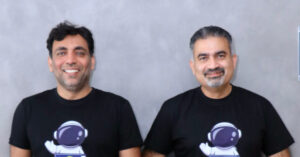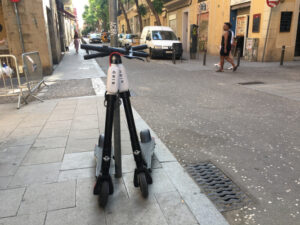Wearable tech could replace a routine or annual visit to your doctor.
Researchers from UC San Diego have developed a wearable device to monitor vital metrics like glucose, lactate, and alcohol levels.
Independently, University of Texas researchers have collaborated with EnLiSense, a medical device manufacturer, to develop wearable sensors that identify infections through sweat signals.
These latest developments would allow people to detect medical issues early, cut the number of unnecessary diagnostic tests and medical procedures, and better assist healthcare providers.
If wearable tech offers higher functionalities at a lower price, they offer immense advantages. We expect more developments in wearable trackers along with wider adoption. Businesses can utilize it to monetize this 100+ billion USD opportunity.
Read Also: Metamaterial Antenna Will Soon Replace Batteries in Small Devices
“Lab on the Skin”
The multitasking device developed by researchers from the Center for Wearable Sensors, UC San Diego (1), is only about the size of a six-quarters stack. Users can apply it on the skin using a Velcro-like patch of microneedles. They are about one-fifth the width of a human hair. Since these microscopic needles barely pierce the skin’s surface, they are not painful.
The microneedles penetrate the skin’s surface to sense biomolecules in the interstitial fluid; the fluid surrounds our cells beneath the skin. Users can wear the device on their upper arm and send data to a custom smartphone app.
Researchers behind the technology had described their device in a paper published on 9th May in Nature Biomedical Engineering. Click here to read the full paper.
“It is like a lab on the skin,” said Joseph Wang, a nanoengineering professor at UC San Diego and a paper’s co-corresponding author (2). “It can continue measuring multiple biomarkers simultaneously, allowing users to monitor their health and wellness as they continue with their daily activities.”
Most commercial health monitors available today, including continuous glucose monitors for diabetic patients, only measure one signal. The issue with it is that it leaves out crucial information that could have helped diabetic patients manage their condition more effectively.
For instance, monitoring alcohol is useful since drinking alcohol can drop sugar levels. Knowing both levels can help people better manage their blood sugar if they drop too low after having a drink. We can also combine the information about lactate levels, which users can monitor while exercising to detect muscle fatigue. It is helpful since physical activities can influence the body’s ability to regulate blood sugar.
“Our wearable helps people see the interplay between their glucose level fluctuations with their exercise, diet, and alcohol consumption. It could add to their quality of life,” said the first co-author of the paper, Farshad Tehrani (3).
Tehrani and fellow co-author Hazhir Teumourian have co-founded a startup company called AquilX to develop wearable tech for further commercialization. They aim to improve the duration of the microneedle patch before replacing them. The company is also excited to add more sensors to the device to monitor patients’ medication levels and other health signals (4).
Read Also: Biohacking: An Industry With Opportunities Worth Over $50 Billion
Telltale Infection Signs Using Body Sweat
A team of bioengineers from the University of Texas, Dallas, has teamed up with EnLiSense LLC to build a wearable device, SWEATSENSER, that can determine the prevalence of various infections via body sweat (5).

The study, published in Advanced Materials Technologies, found that sweat sensors can detect two critical biomarkers:
- IP-10: a gamma-inducible protein
- TRAIL: tumor necrosis factor-related apoptosis-inducing ligand
If a sensor detects high levels of either biomarker in your sweat, it is a sign of a cytokine storm happening in your body. A cytokine storm refers to an immune reaction when our body contracts a severe infection. Cytokines are small proteins released by our cells that have specialized effects on communication between cells – essential for our immunity.
The head of bioengineering, Dr. Shalini Prasad (6), called detecting these markers through sweat “groundbreaking.”
“Our work is pioneering because there was no clarity if these markers were present in body sweat until now. We have established that the low-volume passive sweat tech we developed can measure these molecules,” said Dr. Prasad.
The study opens new avenues to further investigate a comprehensive noninvasive system for real-time detection of infection for evidence-based clinical management via the sweat sensor wearable tech. It will serve not only as an early warning system for infections like COVID-19 and flu but also offer better evidence-based prognosis and patient-focused therapeutic intervention.
Read Also: Health Tech Revolution, Diabetes Apps Market, and Emerging Trends
Wearable Tech Tracking Cancer
Earlier this year, Greater Manchester started a trial of wearable tech for cancer patients (7). The trial, called EMBRaCe, Enhanced Monitoring for Better Recovery and Cancer Experience, is a collaboration between the University of Manchester, Manchester University NHS Foundation Trust, and The Christie NHS Foundation Trust.
The trial will initially study blood cancer, lung, and colorectal cancer patients using technologies, including:
These devices access a range of vital signs, including heart rate, temperature, sleep, ESG, and physical activity levels.
“Cancer places a huge burden on our lives worldwide. The study uses cutting-edge wearable tech to monitor people during their treatment. We hope it will offer new insights into how people cope with cancer treatment and what we can do to improve their recovery,” said Dr. Anthony Wilson, the project leader and Consultant in Anaesthesia and Critical Care at MRI, Manchester Royal Infirmary (8).
Dr. Michael Merchant, Senior Lecturer in Proton Therapy Physics at Manchester University (9), also believes that data from wearable tech could offer accurate measurement to support patient recovery. Moreover, we can also use wearable devices or fitness trackers to support the development of new cancer treatments by developing clinical trials using digital platforms.
In short, wearable tech has a tremendous potential to make a difference in patients’ lives. We look forward to this study finding key patterns within patient data and helping shape the future of cancer care.
Read Also: Rising Trends: Wearable Birth Control, Print Media, and 3rd-Party Marketplaces
Huge Potential for Wearable Tech
If wearable devices and fitness trackers become cheap and see more functionalities, people could use them to detect medical issues earlier on and improve their overall quality of life (10).
It could also cut the number of unnecessary diagnostic tests and procedures, which cost about 765 billion USD every year in the US alone (11).

Recent research has focused on wearable tech for oncology and tracking other biomarkers (12). Early detection of cancer alone can save as much as 26 billion USD every year (14).
According to Research and Markets (15), the global market for wearable tech could reach over 118.16 billion USD by 2028 with a CAGR of 13.8%. Even though we don’t have extensive details on the commercialization of these latest developments in wearable tech, we believe other developers can utilize them to monetize this opportunity.











